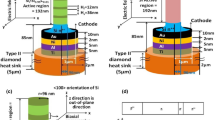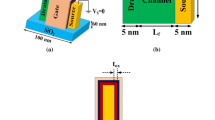Abstract
Modelling/simulation and high-frequency characterization of hetero-junction Avalanche Transit Time (ATT) oscillators, operating in tuned harmonic mode, are reported in the paper. An equivalent circuit, that incorporates self-consistent, non-linear, single-frequency impedance and admittance properties of the device at fundamental, 1st harmonic and 2nd harmonic mode of oscillation frequencies within the THz (0.5–1.5 THz) domain, is simulated. The prospects of Si/4H-SiC versus Si/6H-SiC exotic hetero structures are studied and compared for the generation of considerable amount of RF-power at higher harmonic THz region. For this, a generalised non-linear Mixed Quantum Drift Diffusion (MQDD) model is developed indigenously. The authors have made the simulator realistic by incorporating the temperature dependent carrier ionization rate, saturation drift velocity, mobility and effective mass of the base material-pairs in the analysis. In addition to these, the effects of punch-through phenomena as well as parasitic series resistance related detrimental issues are duly addressed in the present analysis. The authors have made the model realistic by studying the performance of the proposed novel structures under room temperature as well as under elevated temperature conditions. Due to the incorporation of hetero-structure in the active region of the device, considerable amount of power could be generated at 2nd harmonic oscillation frequency (~ 1.7 THz). The study shows that both the Si/4H-SiC and Si/6H-SiC hetero-junction devices are oscillating at 0.5 THz (fundamental frequency). Si/4H-SiC hetero-junction device, due to its less lattice mismatch factor, is more efficient (45%) than its Si/6H-SiC (15%) counterpart under similar structural/electrical/thermal operating conditions. The validity of the MQDD model is established in this paper by comparing the data with corresponding experimental observations at microwave/millimeter-wave region. To the best of authors’ knowledge, this is the first report on harmonic power generation from Si/4H-SiC and Si/6H-SiC hetero-junction ATT devices at higher terahertz region.





















Similar content being viewed by others
References
Adlerstein MG, Holway LH, Chu SL (1983) Measurement of series resistance in IMPATT diodes. IEEE Trans Electron Devices 30:179–182
Ancona MG (2011) Density gradient theory: a macroscopic approach to quantum confinement and tunnelling in semiconductor devices. J Comput Electron 10:65–97. https://doi.org/10.1007/s10825-011-0356-9
Bazin AE, Michaud JF et al (2010) High quality ohmic contacts on n-type 3C-SiC obtained by high and low process temperature. AIP Conf Proc 192:51–54. https://doi.org/10.1063/1.3518309
Buniatyan VV, Aroutiounian VM (2007) Wide gap semiconductor microwave devices. J Phys D Appl Phys 40:6355–6385. https://doi.org/10.1088/0022-3727/40/20/S18
Camara N, Zekentes K et al (2006) Microwave pin diode and switches based on 4H-SiC. IEEE Electron Device Lett 27:108
Canali C, Ottaviani G, Quaranta A (1971) Drift velocity of electrons and holes and associated anisotropic effects in silicon. J Phys Chem Solids 32(8):1707
Chang K, Thrower WF, Hayashibara GM (1981) Millimeter-wave silicon IMPATT sources and combiners for the 110–260-GHz range. IEEE Trans Microw Theory Tech 29:1278
Chen CC, Mains RK, Haddad GI (1991) High power generation in IMPATT devices in the 100–200 GHz range. IEEE Trans Electron Devices 38:1701
Chen X, Li T, Zeng H et al (2016) Numerical and experimental investigation on micromixers with serpentine microchannels. Int J Heat Mass Transf 98:131–140
Dalle C, Rolland PA, Lleti G (1990) Flat doping profile double drift silicon IMPATT for reliable CW high power, high efficiency generation in the 94 GHz window. IEEE Trans Electron Devices 37:227
Davydov VY, Klochkin AA, Seisyan RP, Emtsev VV, Ivanov SV, Bechstedt F, Furthmuller J, Harima H, Mudryi AV, Aderhold J, Semchinova O, Graul J (2002) Absorption and emission of hexagonal InN. Evidence of narrow fundamental bandgap. Phys Stat Solidi B. https://doi.org/10.1002/1521-3951(200202)229:3%3cR1:AID-PSSB99991%3e3.0.CO;2-O
De P, Chakraborty PK (2004) Effect of punch through on the microwave series resistance of n+np+ Si IMPATT diodes around the X band. Semicond Sci Technol 19:859–863. https://doi.org/10.1088/0268-1242/19/7/014
Dmitriev VD et al (1995) SiC a (3) n alloys and wide band gap nitrides on SiC substrates. Int Phys Conf Ser 141:497–502
Fong TT (1979) Millimeter-wave pulsed IMPATT sources. IEEE Trans Microw Theory Tech 27:492
Gardner CL (2006) The quantum hydrodynamic model for semiconductor devices. SIAM J Appl Math 54(2):409. https://doi.org/10.1137/S0036139992240425
Gibbons G (1973) Avalanche diode microwave oscillators. Clarendon Press, Oxford
Gilden M, Hines ME (1966) Electronic tuning effects in the read microwave avalanche diode. IEEE Trans Electron Devices 13(1):169–175
Gong M, Zhou W, Tsai MC et al (2014) Nanoscale nickel oxide/nickel heterostructures for active hydrogen evolution electrocatalysis. Nat Commun 5:4695
Grov AS (1967) Physics and technology of semiconductor device. Wiley, New York
Groves IS, Lewis DE (1972) Resonant cap structures for IMPATT diodes. Electron Lett 8:98
Gummel HK, Blue JL (1967) A small-signal theory of avalanche noise in IMPATT diodes. IEEE Trans Electron Devices 14(9):569–580
Gupta MS, Lomax RJ (1973) A current-excited large-signal analysis of IMPATT devices and its circuit implementations. IEEE Trans Electron Devices 20:395–399
Gurbuz Y et al (2005) Diamond semiconductor technology for RF device applications. Solid State Electron 49:1055–1070
Hunt B, Sanchez-Yamagishi JD, Young AF et al (2013) Massive Dirac fermions and Hofstadter butterfly in a van der Waals heterostructure. Science 340(6139):1427–1430
Iglesias DE, Irvin JC, Nichaus WC (1975) 10 W and 12 W GaAs IMPATTs. IEEE Trans Electron Devices 22:200
Ishibashi T, Ohmori M (1976) 200-GHz 50-mW CW oscillation with silicon SDR IMPATT. IEEE Trans Microw Theory Tech 24:858
Ishibashi T et al (1977) Liquid nitrogen cooled sub-millimeter wave Si IMPATT diodes. Electron Lett 13:299
Johnston RL, De Loach BC, Cohen BG (1965) A silicon diode microwave oscillator. Bell Syst Tech J 44:369
Khan IA, Copper JA (2000) Measurement of high-field electron transport in silicon carbide. IEEE Trans Electron Devices 47:269–273. https://doi.org/10.1109/16.822266
Khan A, Simin G, Yang J, Zhang J, Koudymov A, Shur MS, Gaska R, Hu X, Tarakji A (2003) Insulating gate III-N heterostructure field-effect transistors for high power microwave and switching applications. IEEE Trans Microw Theory Tech. https://doi.org/10.1109/tmtt.2002.807681
Koch M (2005) Terahertz-technology. Quo Vadis Photonik 4:1–5
Kundu A, Adhikari S, Das A, Kanjilal MR, Mukherjee M (2018) Design and characterization of asymmetrical super-lattice Si/4H-SiC pin photo diode array: a potential opto-sensor for future applications in bio-medical domain. Microsyst Technol. https://doi.org/10.1007/s00542-018-4119-4
Lee CA, Batdorf RL, Weigmann W, Kaminsky G (1965) The read diode—an avalanching transit time negative resistance oscillator. Appl Phys Lett 6:89
Luy JF, Casel A, Behr W, Kasper E (1987) A 90-GHz double-drift IMPATT diode made with Si MBE. IEEE Trans Electron Devices 34:1084
Mehdi I, Haddad GI, Mains RK (1988) Microwave and millimeter-wave power generation in silicon carbide avalanche devices. J Appl Phys 64(3):1533–1540. https://doi.org/10.1063/1.341829
Midford TA, Bernick RL (1979) MM-wave CW IMPATT diodes and oscillators. IEEE Trans Microw Theory Tech 27:483
Misawa T (1966) Negative resistance in p–n junctions under avalanche breakdown conditions, part II. IEEE Trans Electron Devices 13:143
Muench WV, Pettenpaul E (1977) Saturated electron drift velocity in 6H-SiC. J Appl Phys 48:4823
Mukherjee M, Roy SK (2009) Optically modulated III–V nitride-based top-mounted and flip-chip IMPATT oscillators at terahertz regime: studies on the shift of Avalanche transit time phase delay due to photogenerated carriers. IEEE Trans Electron Devices 56(7):1411–1417
Mukherjee M, Roy SK (2010) Wide-bandgap III–V nitride based avalanche transit-time diode in terahertz regime: studies on the effects of punch through on high frequency characteristics and series resistance of the device. Curr Appl Phys 10(2):646–651
Mukherjee M, Mazumder N, Roy SK, Goswami K (2007) GaN IMPATT diode: a photo-sensitive high power terahertz source. Semicond Sci Technol 22(12):1258–1260
Mukherjee M, Mazumder N, Roy SK (2008) Photosensitivity analysis of gallium nitride and silicon carbide terahertz IMPATT oscillators: comparison of theoretical reliability and study on experimental feasibility. IEEE TDMR 8(3):608–620
Mukherjee M, Mazumder N, Roy SK (2010) α-SiC nanoscale transit-time diodes: performance of the photo-irradiated terahertz sources at elevated temperature. Semicond Sci Technol 25(5):055008
Neudeck PG, Okojie RS, Chen LY (2002) High-temperature electronics—a role for wide bandgap semiconductors. Proc IEEE 90:1065–1076
Ono S, Arai M, Kimura C (2005) Demonstration of high power X-band oscillation in p+nn+ 4HSiC IMPATT diodes with guard-ring termination. Mater Sci Forum 483:981–984. https://doi.org/10.4028/www.scientific.net/MSF.483-485.981
Pattanaik SR, Dash GN, Mishra JK (2005) Prospects of 6H-SiC for operation as an IMPATT diode at 140 GHz. Semicond Sci Technol 20:299–304. https://doi.org/10.1088/0268-1242/20/3/008
Shockley W (1951) Hot electrons in n-type germanium. Bell Syst Tech J 33:799
Shockley W (1954) Negative resistance arising from transit time in semiconductor diode. Bell Syst Tech J 30:990
Sze SM (1988) Semiconductor devices: physics and technology, 2nd edn. McGraw-Hill International, New York
Sze SM, Ryder RM (1971) Microwave Avalanche diodes. Proc IEEE Spec Issue Microw Semicond Devices 59:1140
Trew RJ (2005) High frequency solid state electronic devices. IEEE Trans Electron Devices 52(5):638–649. https://doi.org/10.1109/TED.2005.845862
Vassilevski K, Zorenko A et al (2001) 4H-SiC IMPATT diode fabrication and testing. In: Technical Digest of international conference on SiC and related materials. ICSCRM 713. https://doi.org/10.4028/www.scientific.net/MSF.389-393.1353
Vassilevski KV, Zekentes K, Zorenko AV, Romanov LP (2000) Experimental determination of electron drift velocity in 4H-SiC p+nn+ avalanche diodes. IEEE Electron Device Lett 21:485
Volz K, Schreiber S, Gerlach JW, Reiber W, Rauschenbach B, Stritzker B, Assmann W, Ensinger W (2000) Heteroepitaxial growth of 3C-SiC on (100) silicon by C60 and Si molecular beam epitaxy. Mater Sci Eng A 289(1–2):255–264. https://doi.org/10.1016/S0921-5093(00)00825-X
Yuan L (2000) Development of silicon carbide IMPATT oscillators. PhD thesis, Purdue University
Yuan L, Melloch MR Jr, Cooper JA, Webb KJ (2000) Silicon carbide IMPATT oscillators for high power microwave and millimeter-wave generation. In: IEEE/Cornell conf. advanced concepts in high speed semiconductor devices and circuit
Yuan L, Melloch MR, Cooper JA, Webb KJ (2001) Experimental demonstration of a silicon carbide IMPATT oscillator. IEEE Electron Device Lett 22:6. https://doi.org/10.1109/55.924837
Zekentes K, Camara N et al (2005) 4H-SiC pin diodes for microwave applications. IEEE (CAS) Conf 1:17–25
Zhao JH et al (2000) Monte Carlo simulation of 4H-SiC IMPATT diode. Semicond Sci Technol 15:1093–1100. https://doi.org/10.1088/0268-1242/15/11/314
Acknowledgements
Dr. M. Mukherjee wishes to acknowledge, Adamas University, for providing necessary infrastructure and facilities for conducting the research program.
Author information
Authors and Affiliations
Corresponding author
Additional information
Publisher's Note
Springer Nature remains neutral with regard to jurisdictional claims in published maps and institutional affiliations.
Rights and permissions
About this article
Cite this article
Chakraborty, D., Mukherjee, M. Si/SiC heterostructure MITATT oscillator for higher-harmonic THz-power generation: theoretical reliability and experimental feasibility studies of quantum modified non-linear classical model. Microsyst Technol 26, 2243–2265 (2020). https://doi.org/10.1007/s00542-019-04580-3
Received:
Accepted:
Published:
Issue Date:
DOI: https://doi.org/10.1007/s00542-019-04580-3




